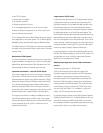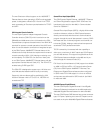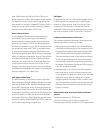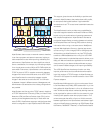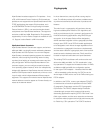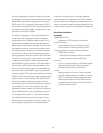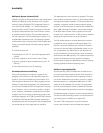31
offl oad). Large send can improve performance by offl oad-
ing outbound TCP segmentation processing from the host
to OSA-Express2 by employing a more effi cient memory
transfer into OSA-Express2. The z/OS Communications
Server support is planned for TCP/IP IPv4 traffi c only and
z/OS and z/OS.e 1.7. In addition, a z/OS and z/OS.e 1.6
PTF is planned to be provided.
Large send support applies to the OSA-Express2 features
(Gigabit Ethernet SX and LX, 10 Gigabit Ethernet LR), sup-
ports QDIO mode only (CHPID type OSD), and is exclu-
sive to z990 and z890. Large send support was previously
announced for the Linux on zSeries environment.
HiperSockets, a feature unique to the zSeries, provides a
“TCP/IP network in the server” that allows high-speed any-
to-any connectivity among virtual servers (TCP/IP images)
and LPARs within a zSeries system without any physical
cabling. HiperSockets decreases network latency and
increases bandwidth between combinations of Linux, z/OS
and z/VM virtual servers. These OS images can be fi rst
level (directly under an LPAR), or second level images
(virtual servers under z/VM).
With new support for up to 16 HiperSockets, the z890 and
z990 provides four times more HiperSockets, and up to
4,096 TCP/IP images (stack) connections, which is also
four times more capacity than the z800 and z900. The
increased HiperSockets capacity and expanded con-
nectivity provides additional fl exibility in designing the
networking to accommodate consolidated and multiple
partitioned systems. HiperSockets can be divided among
Logical Channel SubSystems for separation between vari-
ous LPARs, while at the same time a single LPAR could
have access to all 16 HiperSockets if the HiperSockets all
are assigned to the same LCSS.
A HiperSockets channel also supports spanned channels
in order to communicate between LPARs connected to
different LCSSs. HiperSockets (IQD CHPID type) can be
confi gured to Channel SubSystems and transparently
shared by any or all confi gured LPARs without regard to
the LCSS to which the LPAR is confi gured. This means
one HiperSockets could be common to all 30 z890 or
z990 LPARs. This support is exclusive to z890 and z990.
Different HiperSockets can be used for security (separa-
tion of traffi c, no external wire-tapping, monitoring) and
performance and management reasons (separate sysplex
traffi c Linux or non-sysplex LPAR traffi c).
HiperSockets





